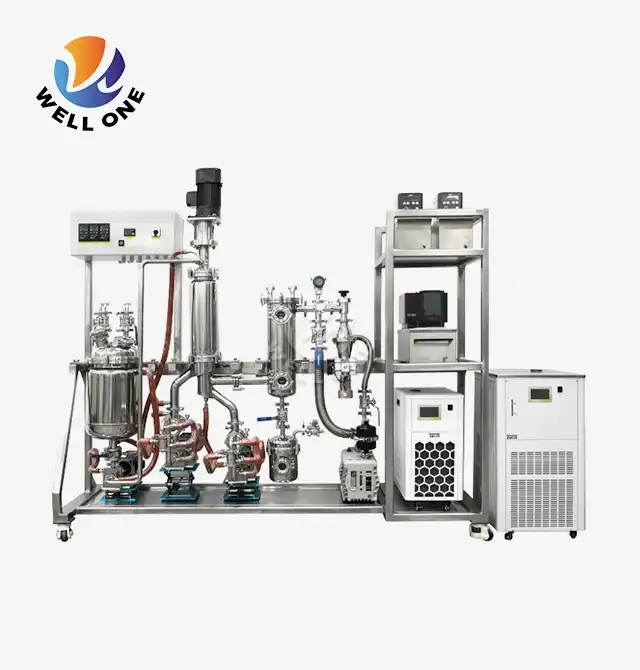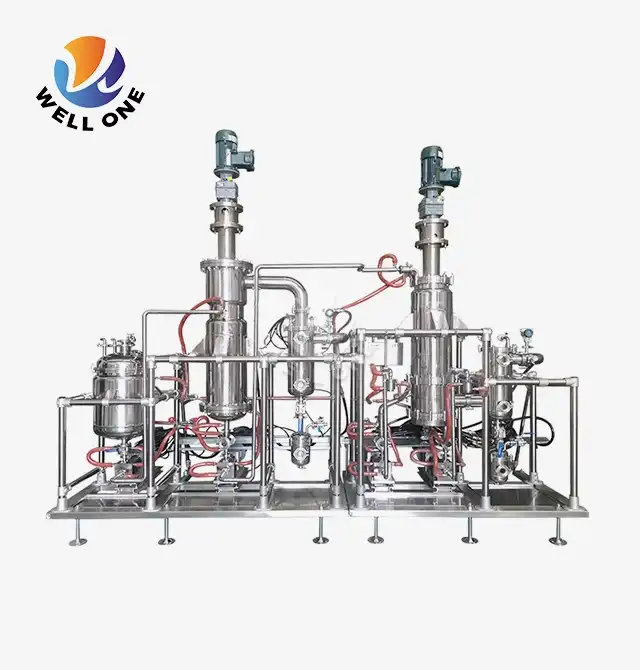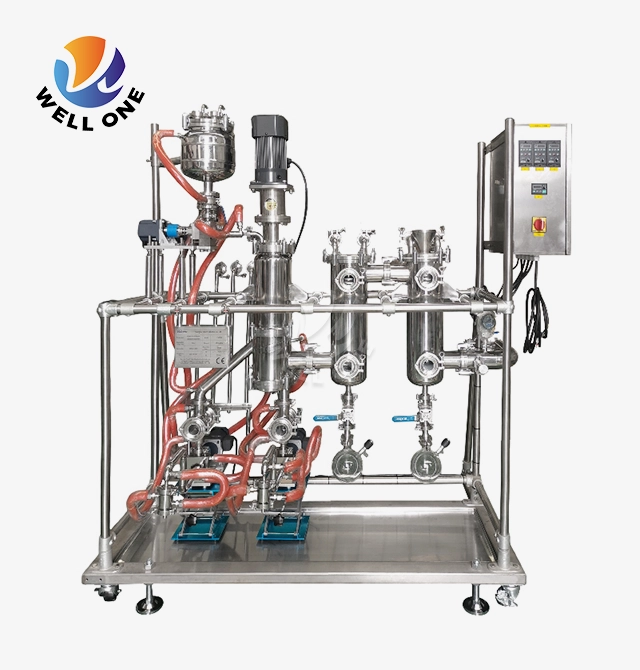What are the key components of a short path distillation kit?
Short path distillation is a purification technique used to distill heat-sensitive compounds and separate mixtures that are close in boiling points. It involves distilling under high vacuum conditions using specialized glassware to achieve shorter distances between the evaporator surface and condenser surface. Understanding the key components that make up a short path distillation kit is critical for performing successful separations. This article will provide an overview of the main parts of a short path distillation apparatus and explain their importance.
Glassware Components
Distillation Flask
The distillation flask, also called an evaporator flask or boiling flask, is where the initial mixture to be separated is placed. This thick-walled, round bottom flask is designed to handle heating of volatile compounds under vacuum. It connects to the rest of the apparatus via ground glass joints. The size of the distillation flask depends on the scale of the distillation being performed.
Condenser
The condenser sits above the distillation flask and serves to cool and condense vaporized compounds. It consists of an inner tube surrounded by a jacket. Coolant, typically water, flows through the jacket while vapors pass through the inner tube and get condensed. Short path condensers have large surface areas optimized for condensing low-boiling point vapors. The condenser attaches to the distillation flask through a curved connector called a cow.
Cold Trap
The cold trap is located between the condenser and vacuum source. It serves as an additional condensing surface that can be cooled to very low temperatures. The cold trap prevents contamination of the vacuum system and also collects less volatile substances, keeping them out of the final distillate. It is usually made of glass and designed for easy removal of condensed liquids.
Receiving Flask
The receiving flask, also called a collection flask, is located after the condenser and cold trap. It collects the purified distillate dripping down from the condenser. It can be a single receiving flask or a fractionating flask setup that allows separation of fractions. The receiving flask detaches easily from the apparatus to isolate the final product.
Heating and Temperature Control
Heating Mantle or Bath
Controlled heating of the distillation flask is crucial for short path distillation. A heating mantle wraps around the flask and applies heat evenly across its surface area. Oil baths and salt baths are also used when higher temperatures are needed. The heat source should evenly distribute heat and allow precise temperature control.
Thermometer/Temperature Probe
A thermometer or temperature probe monitors the temperature of the heating medium or the vapor. Tracking temperature ensures the distillation proceeds at optimal conditions for the compounds being separated. Short path distillations require high precision temperature control for maintaining proper vacuum pressure.
Vacuum System
Vacuum Pump
A high-quality vacuum pump is essential for achieving the vacuum pressures needed for short path distillation. Turbomolecular and diffusion pumps are common choices capable of reaching 0.001 mbar or lower pressure. The pump must be compatible with organic solvents and acids if present. Vacuum pump oil may contaminate the system.
Vacuum Gauge
Vacuum gauges measure the pressure within the apparatus. They allow monitoring the vacuum level during the distillation to ensure it remains stable. Digital gauges provide the most accurate pressure measurements. A single vacuum gauge is usually connected near the cold trap.
Vacuum Hose and Connectors
The vacuum pump connects to the condenser and cold trap using thick-walled vacuum tubing. Stainless steel, PTFE, or PVC hoses are suitable choices. Hose clamps, threaded connectors, and O-ring seals are used to make tight, vacuum-sealed connections.
Safety Equipment
Safety Glasses and Gloves
Distilling under vacuum requires special safety precautions. Thick-walled glassware can implode if defects are present. Proper hand and eye protection in the form of gloves and safety glasses should be worn at all times. Face shields are recommended when handling larger apparatus.
Fire Extinguisher
Although less flammable than atmospheric distillations, short path distillations still carry fire risk. Having a proper fire extinguisher on hand is a necessary safety measure in case of accidental fire. Class B dry powder extinguishers are generally recommended.
Additional Components
Stirrer/Magnetic Stir Bar
Adding a stirrer and stir bar helps maintain uniform mixing and temperature of the boiling liquid. Stirring prevents localized overheating and uneven vaporization. Overhead mechanical stirring is ideal but magnetic stirring can also work.
Clamps and Stands
The distillation flask and condenser must be securely supported on rings or stands with clamps. This prevents glassware from slipping or falling during operation under vacuum. All ground glass joints should be tightly clamped or spring clamped to prevent air leaks.
Conclusion
Short path distillation requires specialized glassware and infrastructure to perform difficult purifications and separations. Key components include the distillation flask, condenser, cold trap, and receiving flask that make up the core apparatus. Heating mantles, thermometers, vacuum pumps, and gauges are critical for providing precise temperature control and vacuum conditions. Safety equipment like gloves, glasses, and fire extinguishers should always be used. Additional components like stirrers, clamps, and stands securely support the setup. Understanding the role and importance of each component allows for building an effective short path distillation kit capable of the challenging separations required in many chemical and industrial applications. With the right setup and precautions, short path distillation can efficiently purify heat-sensitive and low volatility compounds.
Xi'an Well One Chemical Technology Co., Ltd. is a trusted provider of high-quality Short Path Distillation Kits. Our kits are known for their guaranteed quality and widespread use in various industries. As an exclusive export agency authorized by NewSet since 2006, we have built a strong reputation for delivering excellent service and reliable products.
With a focus on meeting the diverse needs of our customers, we offer a range of products including experimental level molecular distillation devices, pilot level molecular distillation devices, industrial level molecular distillation devices, and multi-level continuous use systems. Our commitment to customer satisfaction extends beyond product offerings. We take pride in providing exceptional service to assist you in finding the right product for your specific requirements.
To inquire about our Short Path Distillation Kits or for any further assistance, please don't hesitate to contact us via mobile at (+86) 18191320360 or email us at info@welloneupe.com. We are dedicated to providing top-notch products and ensuring your satisfaction through our expertise and support.
References
Earle, M. J., & Seddon, K. R. (2000). Short path distillation apparatus and method. Journal of Chemical Technology & Biotechnology, 75(7), 665–670.
Saito, M. (2013). An introduction to short path distillation. In Short Path Distillation of Organic Compounds (pp. 1-14). Springer, Cham.
Zhang, J., & Jansen, J. C. (2018). Short path distillation at reduced pressure. In Practical thermochemical conversions (pp. 113-133). Springer, Cham.







